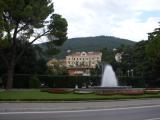
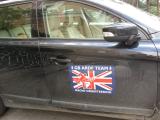
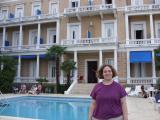
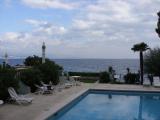
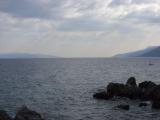
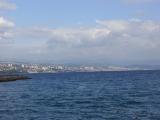
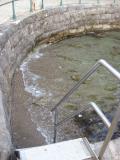
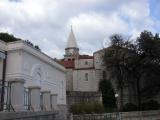
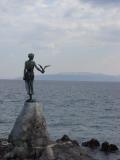
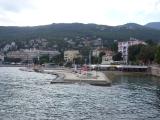
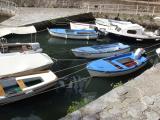
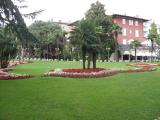
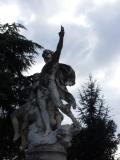
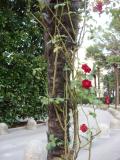
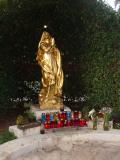
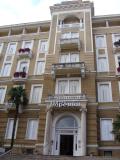
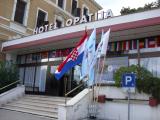
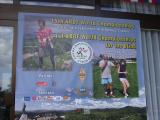
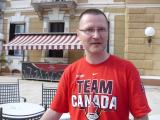
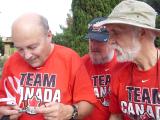
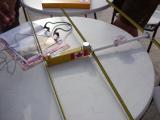
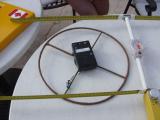
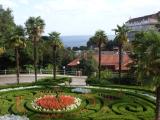
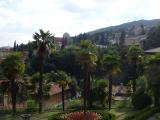

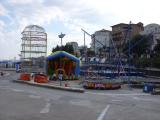
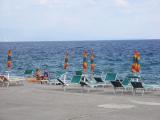
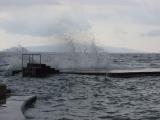
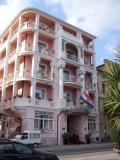
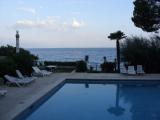
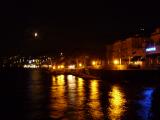
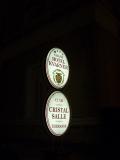
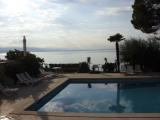
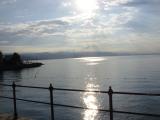
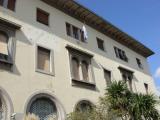
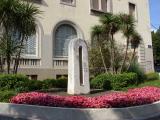
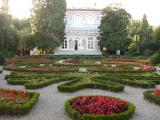
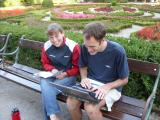
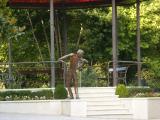
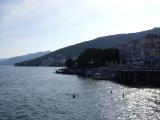
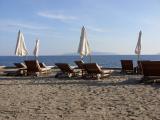
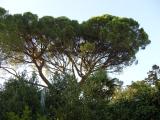
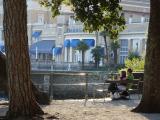
Jen and I attended the 15th World Amateur Radio Direction Finding Championships, September 13-18, 2010, in Opatija, Croatia. It was the first world championships to be held in Croatia, and the first to be held in the former Yugoslavia since the wars of 1991-1995. It was also the first ARDF World Championships with a separate competition for blind competitors. Except for the blind competition (which was held in a soccer field in Opatija), the competition areas were in the nearby Gorski Kotar, the most mountainous region of Croatia. This was our second world championships. Jen was a competitor in the W35 (women, 35 and older) category, and I was a competitor in the M21 (men, any age) category.
These photos are copyright © 2010 Kenneth E. Harker. All rights reserved.
The competition headquarters was in the town of Opatija, a resort town on the Adriatic coast in northwest Croatia. Opatija has more than century-long tradition as a destination resort town. It was first developed in the nineteenth century, when Croatia was part of the Hapsburg Empire, as an Austrian counterpart to the French Riviera. The competition headquarters was in the Hotel Opatija, located on the hillside, overlooking the town and the main waterfront facilities. Teams were spread around to six different hotels in the town. Team USA (and Teams Canada, UK, and the Ukraine) stayed in the Hotel Kvarner, the oldest hotel in the town.
 |
The Hotel Opatija, on the hillside above central Opatija. What you can see here is the older, pre-communist portion of the hotel building. The more modern, ugly addition to the hotel is behind the trees to the right. The street in the foreground is Maršala Tita, the main street in Opatija. Between the little park and the Hotel Opatija was the Autobusni Kolodvor Opatija, the Opatija Bus Station, where we arrived from Zagreb. |
 |
We had to walk 400 meters (1/4 mile) or so down the Maršala Tita to the hotel where we would be staying for the next week, the Hotel Kvarner. No single hotel in the area had enough rooms for everyone at the championships. We knew we were staying at the same hotel as the British team when we walked past this car in the parking lot. |
 |
Jen Harker W5JEN (W21) at the Hotel Kvarner. The Hotel Kvarner is the oldest hotel in Opatija, built in 1884. It predates electrification, and while there are lights and outlets in the hotel today, there is still no air conditioning or Internet access. Our room actually had sealed off gas pipes in the walls where gas lighting fixtures once were. |
 |
A view of the hotel pool and the Kvarner Gulf of the Adriatic Sea. The hotel pool was filled with salt water and was almost as cold as the sea. |
 |
The Kvarner Gulf was calm on the day we arrived at the hotel. The Kvarner Gulf is formed by a U-shaped bend in the coastline, with the Istrian Peninsula to the west, the Croatian mainland to the north and east, and islands of Cres and Krk to the south. The island on the left is Cres, and the land to the right is part of the Istrian Peninsula. Between 1918 and 1945, both Cres and the Istrian peninsula (where Opatija is located) belonged to Italy, and all schools and churches were forced to use the Italian language rather than Croatian. |
 |
To the northeast of Opatija is the city of Rijeka. Rijeka is the largest port on the Adriatic Sea, and is the principal seaport of Croatia. The population of Rijeka is about 150,000, whereas the population of Opatija was about 13,000. |
 |
A typical Croatian "beach" at Opatija. Mostly, swimming areas were concrete piers with ladders into the water. This was probably at low tide. |
 |
The Sv. Jakoba Church was next door to the Hotel Kvarner. It is the oldest church in the town, dating to 1449, although this particular building only dates to the 19th century. The church bells must have been rung 50 times a day. |
 |
The famous Maiden with the Seagull statue by Zvonko Car (1956). This statue replaced a religious statue of the Madonna that the communists removed from the promontory in the 1950s. |
 |
This concrete beach on the Lungomare (the Seaside Promenade) was the main swimming area for the town. It was cold enough that few people were enjoying the coffee bars, let alone swimming in the water. The Lungomare was a 12 kilometer (7.5 mile) long pedestrian path along the seaside that goes all the way from Rijeka in the north, through Opatija, to Lovran in the south. |
 |
Some small boats, tied up in an alcove on the Opatija waterfront. Opatija was a fishing village until the late 19th century, when tourism became important. |
 |
Sv. Jakoba Park, next to the Hotel Kvarner. |
 |
Helios and Selena, an 1889 fountain statue in Sv. Jakoba Park by Austrian sculptor Hans Rathautsky. |
 |
Roses climbing the palm trees in Sv. Jakoba Park. |
 |
This golden statue of the Virgin Mary, the "Madonna del Mare" was in an outdoor shrine at Sv. Jakoba Church. It is a replica of the statue that used to sit on the promontory where the Maiden with the Seagull statue now sits, but was removed by the communist government in the 1950s. It reminds me of the golden Buddha statues we saw in 2008 in Korea. |
 |
The Hotel Imperial was one of the hotels that housed teams for the championships. It was the second hotel built in the town, and opened for business in 1885. Marvin Johnston KE6HTS (juror) and Dennis Schwendtner WB6OBB (Blind, Senior) stayed in this hotel. Supposedly, the author James Joyce once stayed at the hotel, and it was the favorite hotel for Franz Josip Tito, the communist dictator of Yugoslavia from 1945 to 1980, when he was in Opatija. |
 |
The Hotel Opatija was a nice old pre-communist building that had a fairly ugly addition tacked onto its northern side. The lobby entrance is now in the new, modern portion of the hotel, and was decorated during the championships with the national flags of the countries at the championships. The hotel web site uses cleverly framed photographs to hide the modern wing of the building in all of their publicity. |
 |
The championship banner/poster. Sponsors included both Ožujsko beer and Red Bull energy drink - probably best not consumed together. |
 |
Although they were staying at the same hotel as us, we first ran into the members of Team Canada on the patio in front of the Hotel Opatija. This is Amel Krdzalic VA7KBA (M40). |
 |
Les Tocko VA7OM (M60) and John MacConnachie VE7GED (M60) are examining a small transmitter board designed by Nick Roethe VE/DF1FO. Looking over their shoulders is Joe Young VE7BFK (M60). From Victoria, British Columbia, Joe is the Radio Amateurs of Canada ARDF Coordinator, and has been active in the sport since 1993. |
 |
The 144 MHz receiver of Nick Roethe VE/DF1FO. Nick is an electrical engineer, and designs and builds his own receivers by hand. |
 |
This was a low power 144 MHz transmitter designed and built by Nick Roethe VE/DF1FO. |
 |
The garden below the Hotel Opatija, and the view from the patio to the Kvarner Gulf. |
 |
The town of Opatija, as seen from the patio of the Hotel Opatija. The blue domed building is Crkva Marijina Navještenja, or the "Church of the Annunciation", which was constructed in the early 20th century. |
 |
The front of the modern wing of the Hotel Opatija became covered in the national flags of the competitors. |
 |
A playground for children down by the waterfront was deserted by early September. The trampolines have the corporate logo of Ožujsko, the largest brewery in Croatia. |
 |
Very few sunbathers were out on the first day we were in town. |
 |
Later in the week, the seas became a little rougher. |
 |
The Hotel Mozart was a five-star hotel (according to the Croatian National Tourist Board) in downtown Opatija. The Hotel Kvarner (where we were staying) was only three stars. |
 |
The saltwater pool at the Hotel Kvarner in the late afternoon. |
 |
The waterfront side of the Hotel Kvarner, at night, as seen from Angiolina Park, north of the hotel. |
 |
The main sign for the Grand Hotel Kvarner and the grand ballroom (the "Cristal Salle" or Crystal Hall), lit up at night. The best part of this sign is that you can tell it was made with four stars above the word "Grand". One of those stars is now covered up. This means that the hotel lost a star from the Croatian National Tourist Board, and was too cheap to buy a new sign. |
 |
The saltwater pool at the Hotel Kvarner. |
 |
A view of the Kvarner Gulf from the terrace at the Hotel Kvarner. The ropes in the water marked off a designated swimming area for the hotel and the park next door. |
 |
The Hrvatska Pošta building in Opatija looked a lot more impressive on the outside than it did on the inside. |
 |
A modern art in front of the post office appeared to be in need of a new coat of paint. |
 |
Angiolina Park was next door to the Hotel Kvarner. The pink building is the Villa Angiolina. Built before any hotels in the town, it was the private residence of Iginio Scarpa, a patrician from Rijeka, who dedicated its construction to his late wife. Scarpa was a naturalist, and planted gardens of exotic trees and plants on the property. In the 1860s, the Villa Angiolina was a fashionable salon for the Croatian and Austrian elite, and introduced Opatija as a tourist destination. Today, the villa houses half of the Museum of Croatian Tourism. |
 |
Lori Huberman (W21) and her boyfriend Stephen Granger-Bevan (non-competitor). We liked to call Angiolina Park the "WiFi Park", as it had a free WiFi access node, and was the closest source of Internet access. Unless it rained. |
 |
Next to the Villa Angiolina was a pavilion with this modern art sculpture of a violinist. |
 |
People swimming in the sea in front of the Hotel Kvarner. The hotel had its own little private concrete beach and roped off swimming area. We went in for a swim on Tuesday, after the model event. |
 |
Next to the Angiolina Park was the Lido Beach. The sandy "beach" with chairs and umbrellas was actually atop a stone seawall at least a meter above the water. There was a diving board and ladders were available for getting in and out of the water. There was also a little bar selling coffee, beer, and cocktails. |
 |
Angiolina Park was full of exotic trees and plants that you would not find elsewhere in Croatia. |
 |
Another view of the Hotel Kvarner, seen from Angiolina Park. |
The first day of the ARDF World Championships is always a model event. This is a chance for the organizers to deploy the exact transmitters that will be used in competition, and a chance for the competitors to test their equipment and get used to the local terrain. The model event was held on Tuesday, September 14, in a park next to the Bajer Jezero hydroelectric reservoir in the mountain town of Fužine. Although the town was only 10 km (6 miles) from the Adriatic Sea, it was 730 meters (2,395 feet) above sea level, in a mountainous region of Croatia known as the Gorski Kotar, a sub-region of the Dinaric Alps. The map contained one peak in the center, which rose about 105 meters (345 feet) above the reservoir.
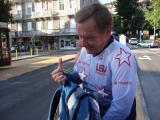 |
The buses to the model event left the Autobusni Kolodvor Opatija (Opatija Bus Station) at 9:00 AM. We showed up a few minutes early. Jay Hennigan WB6RDV (M50) wore his team uniform for the model event. Jay is from Santa Barbara, California. |
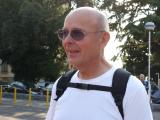 |
Harley Leach KI7XF (M60) came to the Championships from Bozeman, Montana. |
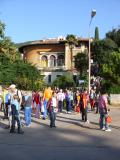 |
Crowds of competitors walking down the stairs from the Hotel Opatija. |
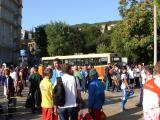 |
The orange bus was a city bus. The city buses connected Opatija to Rijeka in the north and Lovran in the south. We took ten charter coaches, and each team was assigned to a particular bus. This enabled team captains to make sure everyone from their team was on the bus. |
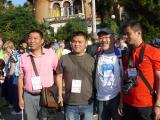 |
Hiroshi Izuta JF1RPZ, from Japan (third from left), and three non-competitors from China. Hiroshi used to live in the United States and compete in USA ARDF Championships. At this World Championships, he was an International Juror. |
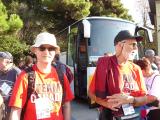 |
Amel Krdzalic VA7KBA (M40) and John MacConnachie VE7GED (M60). Both came to the World Championships from British Columbia, although Amel was born in nearby Bosnia. Amel sat near the front of the bus and chatted with the driver during the drive. |
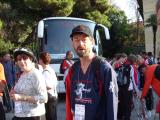 |
Ewen Templeton VK3OW (M40), half of Team Australia. Ewen came to the World Championships from the greater Melbourne area. |
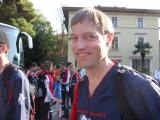 |
Bruce Paterson VK3TJN (M40), the other half of Team Australia. Bruce also lives in the state of Victoria, not far from Melbourne. |
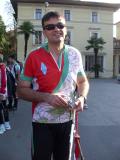 |
I thought Bulgaria had the most striking and interesting team kit at the Championships this year. |
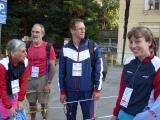 |
Ruth Bromer WB4QZG (W60), Joseph Huberman K5JGH (non-competitor), Vadim Afonkin KB1RLI (M40), and Lori Huberman (W21). Ruth and Joseph came to the World Championships from North Carolina. Vadim and Lori both live in eastern Massachusetts. |
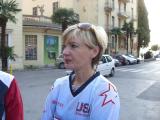 |
Alla Mezhevaya (W21) lives in eastern Massachusetts and was recruited onto Team USA by Vadim Afonkin KB1RLI. Like Vadim, she was born in Russia. |
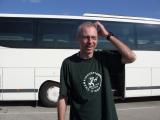 |
A total of ten charter coach buses were needed to transport all of the competitors. The buses stopped at a scenic rest area on the tollway between Opatija and Rijeka to let the caravan reassemble after leaving Opatija for the open road. David Williams M3WDD (M40) sports an official T-shirt that he got for being a team leader. |
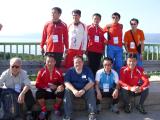 |
Team Korea was also on our bus, and they posed with me for a photo. Seated at the far right is Yoo Dong Gul DS4OMS (M21). He was the technical operator I was paired with at the 2008 World ARDF Championships, where I was an international juror, responsible for observations at one of the transmitters on the course. |
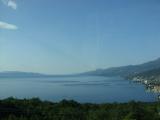 |
The Kvarner Gulf on the Adriatic Sea. The town of Opatija is on the right. |
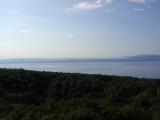 |
The view to the south-southeast. The island on the right is Cres, and the island on the left is Krk. Krk is the most populated island in the Adriatic Sea, with over 17,000 residents. |
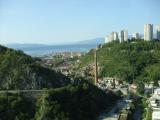 |
Part of the port city of Rijeka, as seen from the tollway. Rijeka is the largest port on the Adriatic Sea (handling more cargo than even Venice), and is the principal seaport of Croatia. |
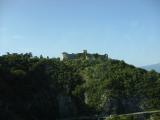 |
We saw this castle on a hill close to the modern tollway. |
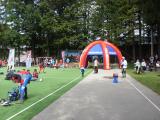 |
The buses dropped everyone off at a park next to the Bajer Jezero hydroelectric reservoir in the mountain town of Fužine. The inflatable finish tent belongs to Orijentacijski Klub Ris Delnice, the local orienteering club based in the mountain town of Delnice. Volunteers from the orienteering club helped throughout the competition. |
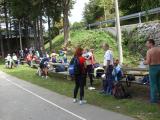 |
ARDFers take over the picnic tables. |
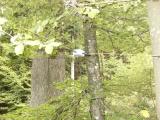 |
Out in the field, this was one of the 144 MHz transmitter antennas. Known as a turnstile antenna, it is horizontally polarized and omnidirectional. |
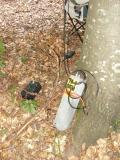 |
The transmitter and a sealed lead-acid (gel cell) battery. This was MOH, or transmitter number four. |
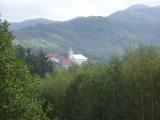 |
The church steeple in the mountain town of Fužine, as seen from a high meadow. 88% of the population living in Croatia identify themselves as Roman Catholics. |
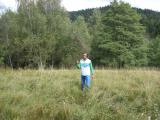 |
One of the competitors, searching for a 3.5 MHz transmitter. While some wore their uniforms at the model event, others did not. |
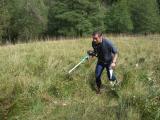 |
This runner's 144 MHz receiver was interesting. The element spacing is very unusual. The antenna is almost certainly homemade. |
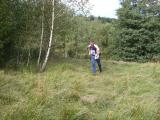 |
Another runner, looking for a 3.5 MHz transmitter. |
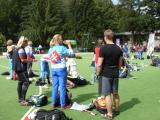 |
Team Slovakia, back at the sport courts. |
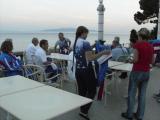 |
Team USA had team meeting each night after dinner. On Tuesday night, we held the meeting on the hotel patio. Everyone is dressed in team uniforms to go to the opening ceremony after the meeting. |
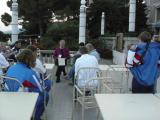 |
Dale Hunt WB6BYU (M50) and Kuon Hunt KB7WRG (non-competitor Team Captain) review the announcements and news from the Team Captains meeting held in the afternoon. As the IARU Region II ARDF Coordinator, Dale was required to attend the Team Captains meeting as well as Kuon. He also had to wear a tie to the Opening Ceremony. The big issue for the day was whether or not GPS units without navigational displays (such as Garmin Forerunner watches) would be allowed on course. |
The Opening Ceremony for the 15th World ARDF Championships was held after dinner on Tuesday, September 14 in the Grand Ballroom of the Hotel Kvarner. Opening Ceremonies typically include speeches by dignitaries, the presentation of nations, and local cultural performances. This year, the cultural program was a group of women a cappella singers and an accordionist.
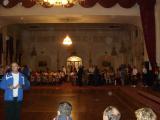 |
The "Crystal Hall" of the Hotel Kvarner was configured with a dance floor in the center of the room. Chairs were set up on either side, at a 90 degree angle from the stage (to the right). |
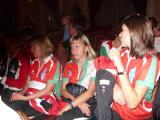 |
We were sitting near Team Bulgaria. |
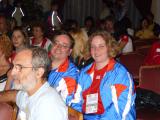 |
Jen Harker W5JEN (W35) and Ken Harker WM5R (M21) at the Opening Ceremony. |
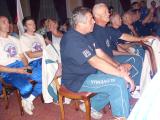 |
Team France and Team Slovenia. |
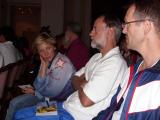 |
Alla Mezhevaya (W21), Bob Cooley KF6VSE (M60), and Vadim Afonkin KB1RLI (M40). Bob came to the World Championships from northern California. |
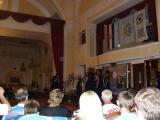 |
These women sang Croatian songs both before, and after, the parade of nations. At least eight different songs that basically all sounded the same. |
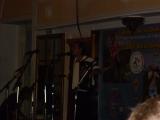 |
The other major component of the cultural program was this accordionist. Eventually, the women and the accordionist joined forces. |
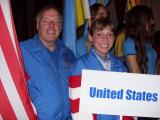 |
Carrying the flag for the United States was Dick Arnett WB4SUV (M60) from Kentucky. Dick was one of the organizers of the 2010 USA ARDF Championships. Lori Huberman (W21) carried the United States sign. |
The first day of competition was on Wednesday, September 15. Competitors took buses from Opatija to the competition venue, the forest near Lividraga. Close to the border of Slovenia, Lividraga is an alpine hunting lodge that was a favorite retreat of Josip Broz Tito, the dictator of communist Yugoslavia from 1945 to 1980. Tito used Lividraga both for recreation and for conducting political business in a more private setting away from the national capital of Belgrade. Located in the Gorski Kotar, the forest around Lividraga is actively logged, and unfortunately, many logging roads were not on the map. The finish area was at 1,014 meters (3,325 feet) above sea level. Some competition classes ran on 144 MHz (all the men except M40) on this day and others ran on 3.5 MHz (all the women plus M40). Jen ran on 3.5 MHz, and I ran on 144 MHz. I had a late start, so I took a lot of pictures. It was a beautiful, sunny day.
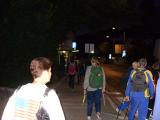 |
The buses to the start left the Autobusni Kolodvor Opatija at 6:00 AM sharp. The Hotel Kvarner was about 400 meters (1/4 mile) from the bus station. I wonder what the early morning delivery drivers showing up at the businesses on the Maršala Tita thought of all these strangely attired athletes walking through town before dawn. |
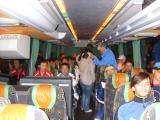 |
The bus begins to fill with competitors, coaches, and team captains. |
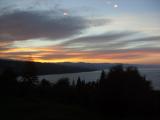 |
The sunrise over the Kvarner Gulf. |
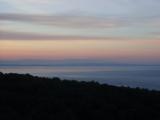 |
We stopped again at the same scenic rest stop on the tollway between Opatija and Rijeka. I got out of the bus to enjoy the sunrise. |
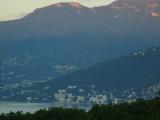 |
The town of Opatija in the distance. |
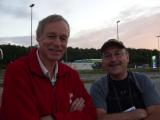 |
Nick Roethe VE/DF1FO (M50) and Les Tocko VA7OM (M60). |
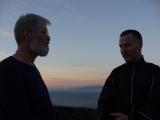 |
Dale Hunt WB6BYU (M50) and Amel Krdzalic VA7KBA (M40). |
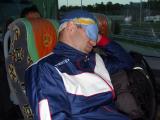 |
Back on the bus, Vadim Afonkin KB1RLI (M40) came prepared to catch some extra rest. |
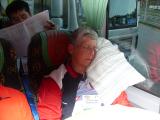 |
Ruth Bromer WB4QZG (W60) brought a pillow. |
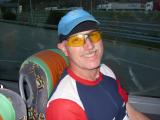 |
Jerry Boyd WB8WFK (M40) is a morning person. Jerry came to the World Championships from Albuquerque, New Mexico. |
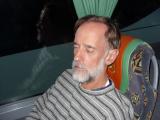 |
Bob Cooley KF6VSE (M60) takes a nap. |
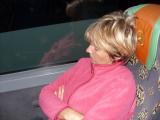 |
Alla Mezhevaya (W21). |
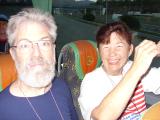 |
Dale Hunt WB6BYU (M50) and Kuon Hunt KB7WRG (Team Captain). Kuon had a lot of energy that morning. Dale and Kuon came to the championships from the Willamette Valley in Oregon. |
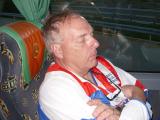 |
Dick Arnett WB4SUV (M60). |
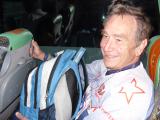 |
Jay Hennigan WB6RDV (M50). |
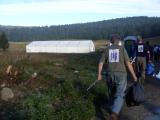 |
A very large tent was set up at the start area for the teams. Early in the morning, it provided some extra warmth. Later in the day, it was shade from the sun. |
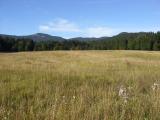 |
The start area was on the edge of large hay field. |
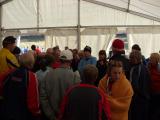 |
An early morning team huddle for the Russians. |
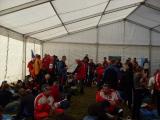 |
We camped out near Team Poland and Team UK. |
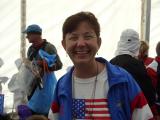 |
Kuon Hunt KB7WRG, our team captain. Kuon made sure everyone was set to go to the start at the right time, and had everything they needed. |
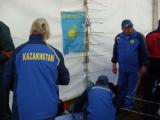 |
Team Kazakhstan hung their 144 MHz receivers on the wall of the tent. It took almost an hour from when we arrived until all the receivers were in the impound area and the transmitters in the field could be turned on. We found out later in the week that Kazakhstan will be site for the 2014 ARDF World Championships. |
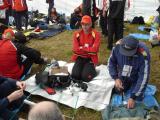 |
Team Belgium was all business. I never one saw anyone on their team smiling. |
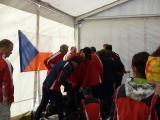 |
Team Czech Republic huddles for some instructions from the team coach. We found out later that they were reviewing the maps of the course. |
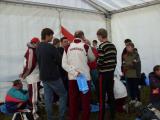 |
Team Hungary. |
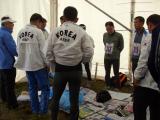 |
Team Korea. |
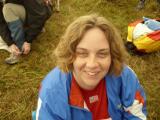 |
Jen Harker W5JEN (W35) had a start time in the middle of the field. |
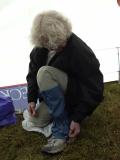 |
Karla Leach KC7BLA (W60) adjusts her gaiters. Many competitors wear some form of covering over their lower legs and the tops of their shoes, to protect against undergrowth. Some competitors even put duct tape over their shoe laces. Karla came to the championships from Bozeman, Montana. |
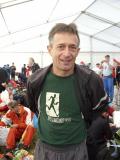 |
George Neal KF6YKN (M50), before the race. George would change into a team uniform before his start. George lives in the New York city area. |
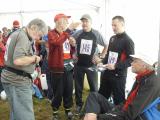 |
This was Team Canada's first participation in a World Championships. From left to right: Joe Young VE7BFK (M60), John MacConnachie VE7GED (M60), Les Tocko VA7OM (M60), Amel Krdzalic VA7KBA (M40), and Nick Roethe VE/DF1FO (M50). |
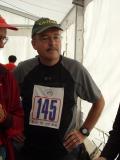 |
Les Tocko VA7OM (M60) came to the championships from Maple Ridge, British Columbia. Les was very active in ARDF in the late 1960s and early 1970s, when he won several national championships in his native Czechoslovakia. |
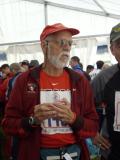 |
John MacConnachie VE7GED (M60), John is from Sidney, British Columbia, a suburb of the city of Victoria. |
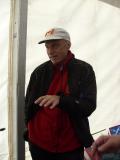 |
Nick Roethe VE/DF1FO (M50) came to the championships from Germany, but competed for Team Canada. Nick was born in Montreal, but his family moved to Germany when he was five years old. Nick's wife, Brigitte Roethe, was competing for Team Germany in the W50 category. Nick and Brigitte have attended several USA and IARU Region II championships in the past. |
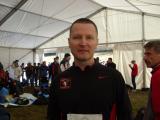 |
Amel Krdzalic VA7KBA (M40). Amel lives in Burnaby, a suburb of Vancouver, British Columbia. Born in Bosnia, Amel first tried ARDF in 1979 when his father took him to the Yugoslavia national ARDF championship. |
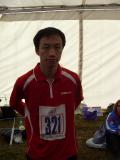 |
Gil Jong Park 6K5TET (M21) ran for Team Korea. He was one of the few competitors I would beat in my category. |
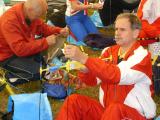 |
A member of Team Poland checks out his receiver prior to delivering it to impound. Teams were called up in alphabetical order to deposit gear in the impound area, so Poland (and the United States) were near the end of the process. |
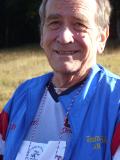 |
Jay Hennigan WB6RDV (M60) outside the tent, in the morning sunshine. The weather on the first day of competition was nearly ideal. |
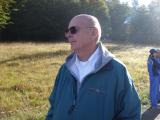 |
Harley Leach KI7XF (M60). |
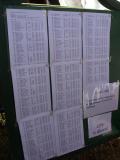 |
Outside the big tent, message boards posted important information for the competitors. This is the start list for all runners in all categories. Team leaders also had printouts of this information. The "GPS is allowed" sign indicates that GPS devices used for tracking (such as the Garmin Forerunner watches) would be allowed on course. The final decision on the matter was made by the jury overnight. |
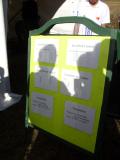 |
The other side of the information board reminds everyone of things they should already know, like the transmitter frequencies, and which transmitters each category skips. Interestingly, the W21 category, which normally skips a transmitter, was required to find all five transmitters at this championships. |
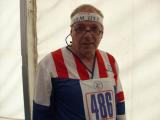 |
Dick Arnett WB4SUV (M60). Dick is wearing the oldest style of Team USA jersey. |
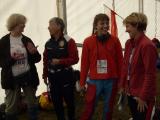 |
Four of the five women competitors on Team USA. From left to right: Karla Leach KC7BLA (M60), Ruth Bromer WB4QZG (M60), Lori Huberman (W21), and Alla Mezhevaya (W21). |
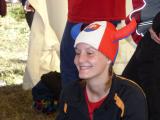 |
This woman from Team Slovakia had a nice hat. |
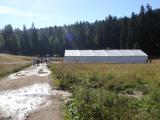 |
The receiver impound was in another tent maybe 100 meters down the dirt road from the big tent. Each team was called up in alphabetical order to walk down to the tent and deposit receivers. Only after all receivers were impounded did the transmitters in the field get turned on. |
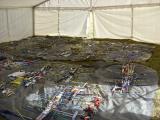 |
Each team basically had a designated spot on which to pile their receivers. Team USA was organized enough to get our runners to deposit their gear in reverse start order, so that when you arrived at the tent for your start, your receiver would be at the top of the stack. It looked like all of the other teams did the same thing, more or less. |
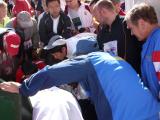 |
Soon after impound was completed, the organizers posted copies of the competition area maps to the information boards. This is highly unusual, but was seen as the only partial remedy to an even bigger problem. The Croatian organizers had not embargoed the competition area, which as it turns out was used earlier in the summer for orienteering competitions. Several ARDF national teams, including the Ukrainians and the Czechs, trained at those meets and came to the ARDF championship with copies of the maps. The jury agreed that this gave some teams an enormous unfair advantage, but the only remedy they could think of was to give everyone a glimpse of the map just a few minutes before the first start. |
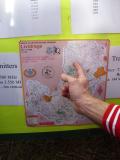 |
The competition area map was 1:10,000 scale. We started in the northeast corner with the finish in the southwest corner. This was identical to the map that we would all be issued at the start. The maps were actually laminated, so I decided to run without a map board, which worked out great. |
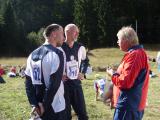 |
Some members of Team Norway. |
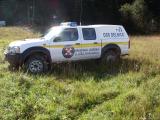 |
The Hrvatska Gorska Služba Spašavanja (Croatian Mountain Rescue Service), a volunteer organization, was on hand. As far as I know, their services were not required. |
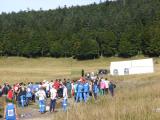 |
As competitors began being called up for the start, more and more people gathered to cheer on their teammates. |
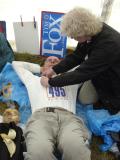 |
Karla Leach KC7BLA (W60) pins a race bib onto Harley Leach KI7XF (M60). The "FOX" sign leaning against the wall of the tent was Harley's map board, made from a recycled election campaign sign. Karla explained the clever reuse of a lightweight yet rigid material to several competitors from other countries. |
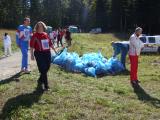 |
Each competitor was issued a blue plastic bag. Before leaving for the start, you put everything you don't need on course (jacket, warm ups, food, water, cameras, umbrellas, receiver cases, a change of clothes, etc.) in the bag. The bags are transported to the finish area where you pick them up after you finish. |
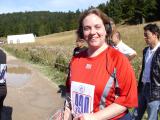 |
Jen Harker W5JEN (W21), moments before entering the start process. Competitors are called up 15 minutes prior to their start time. During those 15 minutes, they proceed in stages to pick up their receivers from impound, collect their maps, check their SportIdent electronic punches, and arrive at the correct starting line for their category. The actual starting lines were in the woods, out of sight of the waiting area, and depending on your entry category you went down one of two start corridors. |
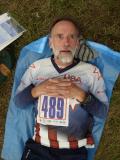 |
Bob Cooley KF6VSE (M60) had one of the latest start times on competition day one. |
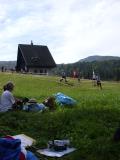 |
The finish area on day one was Lividraga, an alpine hunting lodge that was a favorite retreat of Josip Broz Tito, the dictator of communist Yugoslavia from 1945 to 1980. Tito used Lividraga both for recreation and for conducting political business in a more private setting away from the national capital of Belgrade. The finish corridor was downhill, starting very close to the lodge itself. |
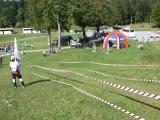 |
The view down the finish corridor from the top of the hill, next to the lodge. |
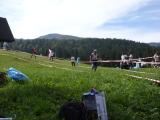 |
Karel Koudelka OK1MAO (M70) of the Czech Republic runs down the corridor. 2010 was the first year for the M70 (men, ages 70 and older) category at a world championships. |
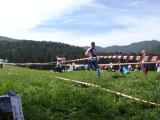 |
Another Czech runner, Jaroslav Zach (M40). The M40 category was the only men's category to run on the 3.5 MHz course on day one. |
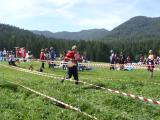 |
John MacConnachie VE7GED (M60) comes in to the finish. |
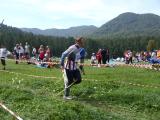 |
Bob Cooley KF6VSE (M60) finished in just 70'48", but still came in 12th place on 144 MHz. |
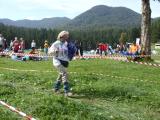 |
Karla Leach KC7BLA (W60) in the finish corridor. With a time of 86'09", Karla would finish seventh individually, but would help earn Team USA a silver medal in the W60 team competition. |
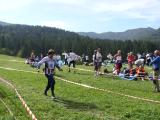 |
Jay Hennigan WB6RDV (M50) had a disappointing run, but did not finish overtime. |
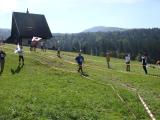 |
Ken Harker WM5R (M21) approaching the finish. I would finish in 47th place out of 54 in my category. Apparently it was a tough course, as 20 out of 54 runners failed to find all five transmitters. |
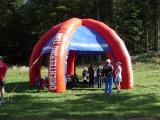 |
The big inflatable finish tent. |
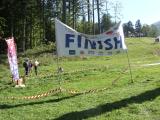 |
The actual finish line. |
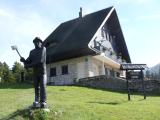 |
The Lovačka Kuća Lividraga (Lividraga Hunting Lodge) has been preserved since the fall of communism. Today, it houses a coffee shop. |
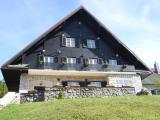 |
The front of the Lividraga lodge faces the west. |
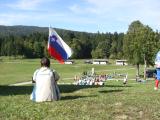 |
A member of Team Slovenia holds a Slovenian flag while watching the finish. I'm not sure you could actually see the Slovenian border from here, although it was very nearby (about 10 kilometers or 6 miles away). 20 years ago, Slovenia and Croatia were both part of Yugoslavia. |
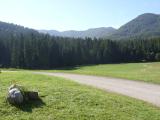 |
The view of the Gorski Kotar mountains to the west-southwest of the finish area. |
The awards ceremony for the first day of competition was held on the evening of Wednesday, September 15 on the patio in front of the Hotel Opatija. Although it was after dark, the view of the town and waterfront below was very nice. Unfortunately, the number of chairs they could fit on the patio was only about half the number of competitors at the championships, so most people at the ceremony were standing. As usual, we got to hear the Ukraine, Russian, and Czech national anthems the most. The real reason we went, though, was to see the United States awarded its first team medal - a silver medal for the W60 category (women, ages 60 and older) on 3.5 MHz.
After a rest day, the second day of competition was on Friday, September 17. The competitors again took buses from Opatija to the competition venue, the heavily forested Risnjak National Park near the town of Crni Lug. ("Crni Lug" translates literally to "black grove"). Located about 15 kilometers (9 miles) from the Adriatic Sea, Crni Lug is 726 meters (2,380 feet) above sea level. Soon after dawn, it began to rain, and it would continue to rain steadily for the next three days. Aside from a half hour at the USA national ARDF championships in 2006, this was my first real experience doing ARDF in the rain. It was cold and wet, and footing on the rocky terrain was terrible. The map was more accurate on this day, but the terrain was challenging, filled with karstic depressions, and the courses were longer. Jen ran on 144 MHz and I ran on 3.5 MHz. I had a relatively early start, so I took fewer photos.
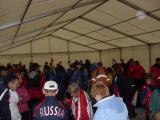 |
Team USA was lucky to be in Bus 2 from Opatija to the start area. The tent was already filling up with competitors when we arrived, and there were some very large puddles inside. It would be very cramped inside for hours. |
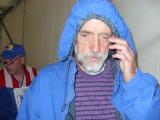 |
Bob Cooley KF6VSE (M60). |
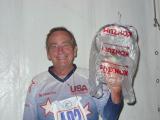 |
Jay Hennigan WB6RDV (M50), starting to water-proof his receiver with a plastic shopping bag. Konzum is the largest chain of grocery stores in Croatia. They ranged in size from very small convenience stores to full-size supermarkets. There was a Konzum on the Maršala Tita between our hotel and the bus station. |
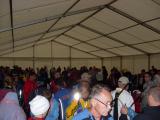 |
The tent gets even more full. |
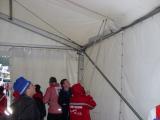 |
One problem with the tent was that water would collect on the roof, and because the roof did not overlap the sides enough, it would drip down the inside of the tent walls. These volunteers are using poles to push the collected water off the roof. They had to repeat this every half hour or so. |
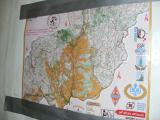 |
As with the first day of competition, the organizers posted the map of the competition area before the first start. At least on this day, it was more than half an hour before the first start. We started in the north central part of the map, and finished in the southwest. I chose to run without a map board again, which worked out, but the map got pretty soggy even with the lamination. |
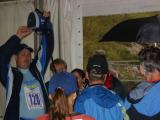 |
Šemsudin Kaltić E75SK (M40), a member of Team Bosnia and Herzegovina, helped out by holding up a speaker so one of the organizers could make the announcement that the first start would be half an hour late. |
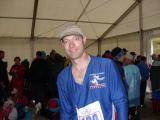 |
Bruce Paterson VK3TJN (M40) from Team Australia. |
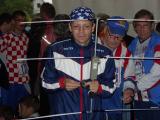 |
Vadim Afonkin KB1RLI (M40) tapes up the elements on his 144 MHz receiver |
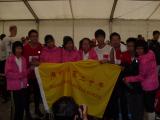 |
Most of the members of Team China came from the city of Guangzhou in southern China, and I guess they all attended the same school. The young ladies on the team all wore pink jackets. |
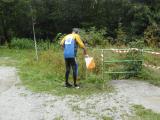 |
Viktor Korshunov (M60), of Team Ukraine, punches in at the finish corridor. Viktor won the gold medal for both 144 MHz and 3.5 MHz in the M60 category. He completed the 3.5 MHz course, in the rain, in just 52'36". |
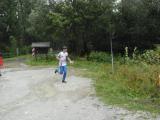 |
A runner from Team Slovakia comes into the finish. You can see the rain coming down in this photo. |
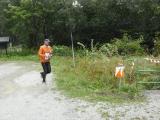 |
Edwin Verburg PE5EDW (M40), from Team Netherlands, juggles receiver and map board getting ready to punch. |
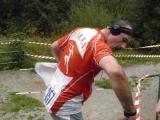 |
Tomasz Deptulski SP2RIP (M40), punching in at the finish corridor. |
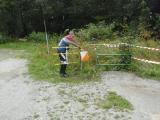 |
Another M40 runner. I would have stuck around to take more photos (PA Nordwaeger SM0BGU was the juror at the finish corridor, and we were having a nice chat), but I was very wet and getting cold. |
The awards for the second day of competition and the closing ceremony and banquet were both held on Friday night, September 17. The awards ceremony was originally scheduled for the patio of the Hotel Opatija, where the first awards ceremony was held, but with the driving rain, that plan was changed. Instead, the awards ceremony was held together with the banquet in the Grand Ballroom of the Hotel Kvarner. A major highlight of the evening for us was watching George Neal KF6YKN awarded a bronze medal for M50 on 3.5 MHz.
|
Last Updated 26 June 2020 wm5r@wm5r.org |